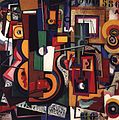Amadeo de Souza Cardoso
Lua error in package.lua at line 80: module 'strict' not found.
| Amadeo de Souza-Cardoso | |
|---|---|

Amadeo de Souza-Cardoso in front of a mirror reflecting his friend Emérico Nunes in the appartement he had on the Boulevard du Montparnasse.
|
|
| Born | 14 November 1887 Mancelos, Amarante, Portugal |
| Died | Script error: The function "death_date_and_age" does not exist. Espinho, Portugal |
| Nationality | Portuguese |
| Known for | Painting |
| Movement | Futurism, Modernism |
Amadeo de Souza-Cardoso (14 November 1887 – 25 October 1918) was a Portuguese painter.
Life
Amadeo was born in Mancelos, a parish of Amarante. At the age of 18, he entered the Superior School of Fine Arts of Lisbon and one year later (on his 19th birthday) he went to Paris, where he intended to continue his studies but soon quit the architecture course and started studying painting. By then, he was especially experienced in caricatures. In 1908, he lived in number fourteen of the Cité de Falguière. There, he went to ateliers in the Académie des Beaux-Arts and the Viti Academy of the Catalan painter Anglada Camarasa. In 1910 he stayed for some months in Brussels and, in 1911, his works were displayed in the Salon des Indépendants. He became close friends with artists and writers such as Gertrude Stein, Juan Gris, Amedeo Modigliani, Alexander Archipenko, Max Jacob, the couple Robert Delaunay and Sonia Delaunay, and Constantin Brâncuși, as well as the German artist Otto Freundlich. He was also friends with the Italian Futurists Gino Severini and Umberto Boccioni.
In 1913, Amadeo de Souza Cardoso participated in two seminal exhibitions: the Armory Show in the USA, that travelled to New York City, Boston, and Chicago, and the Erste Deutsche Herbstsalon at the Galerie Der Sturm in Berlin, Germany, directed by Herwarth Walden. Both exhibitions presented modern art to a public that was still not used to it. Amadeo was among the most commercially successful of the exhibitors at the Armory Show, as he sold seven of the eight works he had on display there.
Amadeo met with Antoni Gaudí in Barcelona in 1914, and then left for Madrid, where the shock of World War I was already underway. His friend Amedeo Modigliani showed sculptures in his Paris studio. Amadeo returned then to Portugal where he married Lucie Meynardi Peccetto. He maintained contact with other Portuguese artists and poets such as Almada Negreiros, Santa-Rita Pintor and Teixeira de Pascoaes. On 25 October 1918, at the age of 30, he died in Espinho, of the Spanish flu.
Work
His early works, under the tutelage of the Spanish painter Anglada Camarasa, were stylistically close to impressionism. Around 1910, influenced both by cubism and by futurism, he became one of the first modern Portuguese painters. His style is aggressive and vivid both in form and colour and his works may seem random or chaotic in their compositional structure at first sight but are clearly defined and balanced. His more innovative paintings, such as "Trou de la Serrure", resemble collages and seem to pave the way to abstractionism or even dadaism.
In 1912 he published an album with twenty drawings, and copied the story of Gustave Flaubert, “La Légende de Saint Julien to l'Hospitalier”, in a calligraphic manuscript with illustrations, but these early works attracted little notice. In 1913 he exhibited eight works in the Armory Show in the USA, some of which are now in American museums. The following year, he returned to Portugal and initiated a great and meteoric career in the experimentation of new forms of expression.
In 1915 Amadeo and other artists such as Santa-Rita, Fernando Pessoa and Mário de Sá-Carneiro joined to shape Orpheu, a magazine which had only two editions and is considered by many to be the exponent of Portuguese modernism. Amadeo also participated in another magazine, Portugal Futurista, which had only one edition published. In 1916, he displayed in Oporto 114 artworks with the heading “Abstraccionism”, that also was displayed in Lisbon, one and another with newness and some scandal. Cubism was in expansion throughout Europe and was an important influence in his analytical cubism. Amadeo de Souza Cardoso explored expressionism and in his last works he tried new techniques and other forms of plastic expression.
In 1925, a retrospective exhibition in France of the painter’s artwork was well received by the public and critics.[citation needed] Ten years later in Portugal, an award was created to distinguish modern painters: the Souza-Cardoso prize.
Some of Amadeo de Souza-Cardoso's ink drawings, decorative but always figurative, slightly resemble those of Aubrey Beardsley.[citation needed] After his death, his work remained almost unknown until 1952, when a room dedicated to his paintings in Amarante Museum gained the public's attention.[citation needed]
Selected artworks
- Retrato de Francisco Cardoso (Portrait of Francisco Cardoso)
- Menina dos Cravos (Carnation Girl)
- Cozinha da Casa de Manhufe (Manhufe's Kitchen)
- Entrada (Entrance)
- Pintura (Painting), Brut 300 TSF
- Os falcões (Hawks), álbum XX dessins, publ. in Paris, 1912
- O castelo (Castle) 1912
- Pintura (Painting), Coty, 1917
- Máscara de olho verde (The Green-eyed Mask), 1916
Bibliography
- Couto, Célia Pinto do / Rosas, M.ª Antónia Monterroso : O Tempo da História vol.2, Porto Editora.
- França, José-Augusto, Amadeo e Almada, Lisbon, Bertrand Editora, 1985.
- Freitas, Maria Helena, et al.: Amadeo de Souza-Cardoso. Avant-Garde Dialogues. Exhibition Catalogue. Calouste Gulbenkian Foundation, Lisbon, 2006.
External links
| Wikimedia Commons has media related to [[commons:Lua error in Module:WikidataIB at line 506: attempt to index field 'wikibase' (a nil value).|Lua error in Module:WikidataIB at line 506: attempt to index field 'wikibase' (a nil value).]]. |
Lua error in package.lua at line 80: module 'strict' not found.




